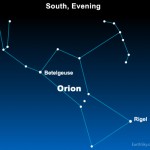
Tonight – or any winter evening – look for the constellation Orion the Hunter. It’s probably the easiest to pick out of all the constellations in the Northern Hemisphere winter sky (Southern Hemisphere summer sky). It’s identifiable by Orion’s Belt, three medium-bright stars in a short, straight row at the mid-section of the Hunter. See these stars? They are easy to spot on the sky’s dome. As seen from mid-northern latitudes, you’ll find Orion in the southeast at early evening and shining high in the south by mid-evening (around 9 p.m. local time). If you live at temperate latitudes to the south of the equator, you’ll see Orion high in your northern sky at this hour. Pick out Orion’s Belt and the nearby bright stars in that part of the sky, and you’ve probably found Orion.
Donate: Your support means the world to us
There’s plenty to see in Orion, too, and it’s easy to find.
Stars in distinct constellations like Orion look connected, perhaps even gravitationally bound, but usually they aren’t. Certainly Orion’s stars aren’t bound to each other by anything but their general location near one another along a single line of sight from Earth. The stars of Orion just happen to make an easy visual pattern on our sky’s dome.
Meanwhile, the stars in Orion and most other constellations are located at vastly different distances from each other. For example, notice the two brightest stars in Orion, Betelgeuse and Rigel. Betelgeuse is estimated to be located 522 light-years away, while Rigel’s distance is 773 light-years.
On the other hand, those prominent stars in Orion’s Belt are somewhat related. They are all giant stars in a nearby spiral arm of our Milky Way galaxy. These stars’ names are Mintaka, Alnilam, and Alnitak.
Bottom line: At this time of year, the constellation Orion the Hunter takes center stage in the star-studded sky! It’s identifiable by Orion’s Belt, three medium-bright stars in a short, straight row at the mid-section of the Hunter.
Why do stars seem brighter in winter?
EarthSky lunar calendars are cool! They make great gifts. Order now. Going fast!
from EarthSky http://bit.ly/2Wp0Fh5

Tonight – or any winter evening – look for the constellation Orion the Hunter. It’s probably the easiest to pick out of all the constellations in the Northern Hemisphere winter sky (Southern Hemisphere summer sky). It’s identifiable by Orion’s Belt, three medium-bright stars in a short, straight row at the mid-section of the Hunter. See these stars? They are easy to spot on the sky’s dome. As seen from mid-northern latitudes, you’ll find Orion in the southeast at early evening and shining high in the south by mid-evening (around 9 p.m. local time). If you live at temperate latitudes to the south of the equator, you’ll see Orion high in your northern sky at this hour. Pick out Orion’s Belt and the nearby bright stars in that part of the sky, and you’ve probably found Orion.
Donate: Your support means the world to us
There’s plenty to see in Orion, too, and it’s easy to find.
Stars in distinct constellations like Orion look connected, perhaps even gravitationally bound, but usually they aren’t. Certainly Orion’s stars aren’t bound to each other by anything but their general location near one another along a single line of sight from Earth. The stars of Orion just happen to make an easy visual pattern on our sky’s dome.
Meanwhile, the stars in Orion and most other constellations are located at vastly different distances from each other. For example, notice the two brightest stars in Orion, Betelgeuse and Rigel. Betelgeuse is estimated to be located 522 light-years away, while Rigel’s distance is 773 light-years.
On the other hand, those prominent stars in Orion’s Belt are somewhat related. They are all giant stars in a nearby spiral arm of our Milky Way galaxy. These stars’ names are Mintaka, Alnilam, and Alnitak.
Bottom line: At this time of year, the constellation Orion the Hunter takes center stage in the star-studded sky! It’s identifiable by Orion’s Belt, three medium-bright stars in a short, straight row at the mid-section of the Hunter.
Why do stars seem brighter in winter?
EarthSky lunar calendars are cool! They make great gifts. Order now. Going fast!
from EarthSky http://bit.ly/2Wp0Fh5

Aucun commentaire:
Enregistrer un commentaire